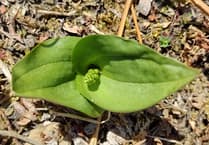There seems to be fewer bees and butterflies around this summer. Insects are vulnerable to unseasonal weather like this year’s cold spring, and to wet summers or drought as they cannot maintain a constant body temperature and rely on the availability of their food plants.
To avoid the cold, some insects like bees hibernate over winter and others wait for spring as an egg or larva. However, some butterflies, dragonflies, ladybirds and hoverflies migrate great distances.
The Marmalade hoverfly is truly the gardener’s friend – a pollinator and its larvae feed on aphids. Exeter University has recorded millions of ‘Marmalades’ crossing the channel each spring and in autumn migrating south over the Pyrenees.
The Painted Lady butterfly migrates from central Africa. Up to six successive generations of butterfly over a summer each head north across Europe. Caterpillars growing while days are lengthening become adults who fly northwards. When days shorten, the butterflies have an impulse to make the 5,000 mile journey back to Africa. This migration was only discovered recently by radar tracking as the butterflies fly so high at 500m or more to take advantage of prevailing winds.
We have lost 80% of our butterflies in the UK since the 1970s, and all our insects are in steep decline. Most of the land in the UK, 70%, is farmed. The area of land treated with pesticides has increased and the types of chemicals used have become more toxic. According to the World Health Organization, the new generation of highly hazardous pesticides or HHPs have much greater toxicity to both humans and wildlife.
These include Glyphosate, a weedkiller that is highly toxic to bees and aquatic organisms. Use between 2016 and 2020 increased, both in terms of land treated and application rate. It is used on pretty much everything, from arable crops to pasture and amenity use. It is even used in regenerative and ‘no till’ agriculture to kill weeds instead of ploughing.
2,4-D is a hormonal herbicide widely used on arable crops. It is toxic to earthworms, aquatic species and bees, is carcinogenic to humans and a suspected endocrine disruptor. Use of this herbicide went up 117% between 2016 and 2020.
Cyantraniliprole is highly toxic to bees and is used on vegetables to kill aphids. The use of this pesticide has risen by a staggering 241% in weight and 345% in land area treated between 2016 and 2020.
Ivermectin is used in livestock farming to worm sheep and cattle. This toxic chemical contaminates the dung and pasture, decimating beetle populations. Fipronil and imidacloprid are killing insects in our rivers. Flea products on domestic pets wash down the drain from households in concentrations exceeding safe limits for wildlife.
Every year, the charity Butterfly Conservation runs a citizen science survey. This year it is more important than ever to take part in their Big Butterfly Count between 12 July and 4 August. And we must urgently cut our use of pesticides before we lose these insects and their amazing migrations forever.





Comments
This article has no comments yet. Be the first to leave a comment.